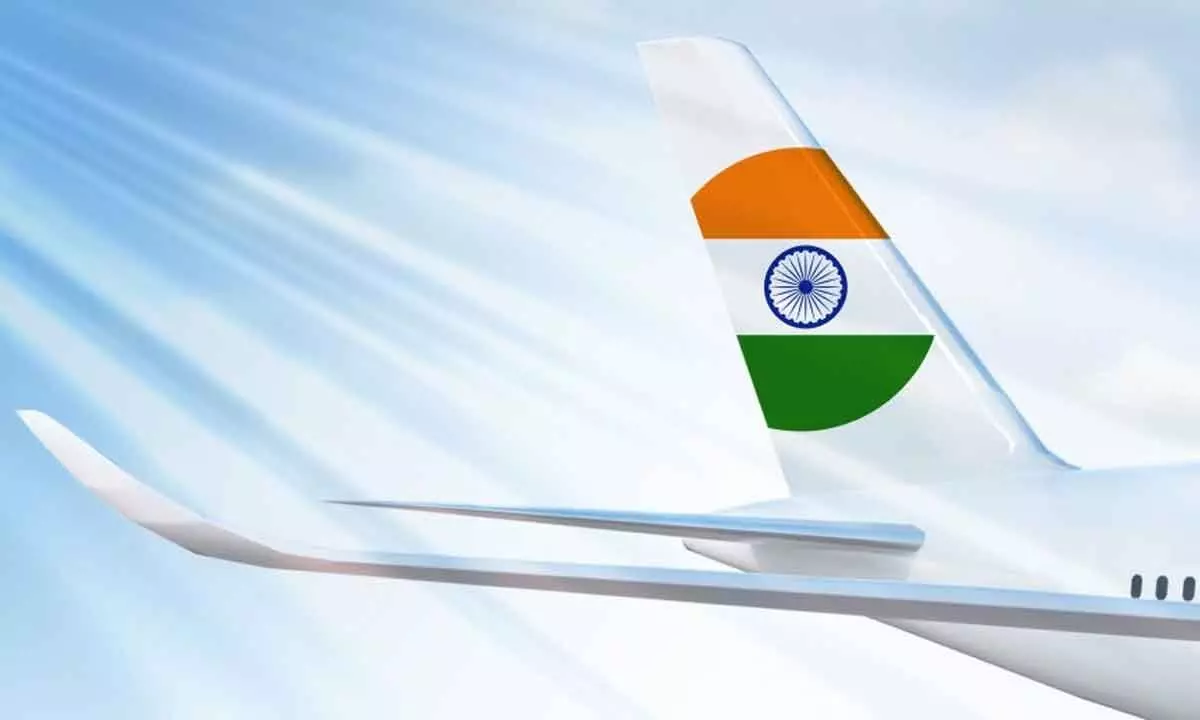Indian aviation market continues to soar high
The industry has a $ 72 billion gross value-added contribution to the GDP
image for illustrative purpose

The India aviation market size is estimated at $ 13.89 billion in 2024, and is expected to nearly double at $ 26.08 by 2030, growing at a CAGR of 11.08% during the forecast period (2024-2030), according to Mordor Intelligence.
The commercial aviation segment is the largest in terms of aircraft delivered in the country. India has become the third-largest domestic aviation market in the world and is expected to overtake the UK to become the third-largest air passenger market this year. The sector contributed five per cent of the GDP, creating four million jobs.
In addition, the industry has a $ 72 billion gross value-added contribution to GDP. Air traffic has been growing rapidly in the country as compared to the global average. The air fleet number is expected to double from the present 600 to 1,200 during 2024.
According to a recent report from CRISIL Ratings, Indian carriers are poised to secure approximately half of the nation’s international passenger traffic by the fiscal year 2027-28. This anticipated surge represents a seven per cent increase from their current 43% share in FY24.
The growth is attributed to various factors, such as expanding routes and introducing new aircraft. Additionally, Indian carriers benefit from their robust domestic network, giving them a competitive edge over their foreign counterparts in capturing the international market.
The report underscores the correlation between the growth of Indian carriers on international routes and the overall rise in the country’s international passenger traffic, which has rebounded to pre-pandemic levels. Consequently, Indian airlines are expected to enhance their business profiles, capitalising on less competitive international routes and yielding higher profits than domestic operations.
To capitalise on this opportunity, the carriers have strategically added 55 new international routes in the past 15 months, surpassing 300 routes. These new routes predominantly cater to popular long-haul destinations such as the United States, Europe and Australia, aiming to minimise travel time and eliminate passenger layovers.
Several factors, including increased disposable income, relaxed visa regulations and improved air travel connectivity, drive India’s international passenger traffic surge. In FY24, international passenger traffic reached approximately 70 million, marking a significant rebound from the pandemic-hit FY21, which stood at 10 million. Moreover, FY24’s traffic surpassed pre-pandemic levels, reaching 67 million passengers in FY20.
Manish Gupta, senior Director and deputy Chief Ratings Officer at CRISIL Ratings pointed out that Indians’ spending patterns are changing since the pandemic. According to him, they are increasingly interested in international leisure travel, which is due to several factors like rising disposable incomes, easier visa procedures, expanding airport infrastructure, and improved air connectivity.
Gupta also emphasised the government’s efforts to boost the tourism sector, which is expected to drive inbound international traffic further. Owing to government initiatives and policy support, he projected a CAGR of 10-11% in international passenger traffic over the next four fiscal years, compared to a mere 5% CAGR in the four years preceding the pandemic.
Over the next 20 years, IATA forecasts growth of 6.1% per year on average – the number of annual air passenger journeys is forecast to increase by more than 350 million over the period, moving to almost 520 million journeys in 2037.
The industry must continue to work constructively with its key stakeholders – including the government and policy-makers – to ensure that this sizeable increase in demand can be met and to realise the full benefits that the air transport industry can deliver to India.
“2024 is off to a strong start despite economic and geopolitical uncertainties. As governments look to build prosperity in their economies in the busiest election-year ever, it is critical that they see aviation as a catalyst for growth. Increased taxes and onerous regulation are a counterweight to prosperity. We will be looking to governments for policies that help aviation to reduce costs, improve efficiency and make progress towards net zero CO2 emissions by 2050,” said Willie Walsh, IATA’s Director General.
Asia-Pacific airlines saw a 45.4% increase in January traffic compared to January 2023, continuing the region’s rapid recovery after the lifting of pandemic restrictions. Capacity climbed 48.1% while the load factor fell by 1.5 percentage points to 82.6%. The exceptionally strong growth rate is largely attributable to China which was in the early stages of lifting Covid-19 travel restrictions in January 2023. The recovery in major international routes to/from Asia-Pacific is still lagging, but routes such as Asia-Middle East have exceeded pre-pandemic levels.

